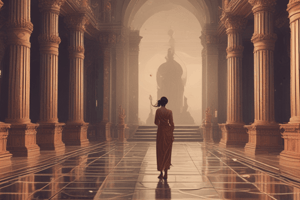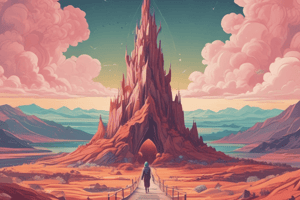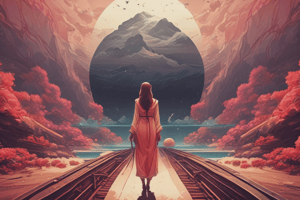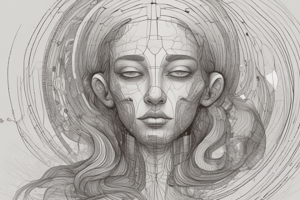Podcast
Questions and Answers
Which of the following best describes the evolution of the meaning of 'Art' from the Ancient World to the 18th Century?
Which of the following best describes the evolution of the meaning of 'Art' from the Ancient World to the 18th Century?
- From expressing feelings and thoughts to crafting tools for survival.
- From technical workmanship to an emphasis on book-learning.
- From a focus on aesthetics to an emphasis on functional crafts.
- From specialized skill or craft to encompassing both fine and useful forms. (correct)
How does art contribute to culture?
How does art contribute to culture?
- By focusing solely on functional crafts rather than fine art practices.
- By embodying ideals and challenging existing norms, beliefs, and assumptions. (correct)
- By strictly adhering to established traditions and beliefs.
- By serving primarily as decorative elements within society.
Why are the Iliad and Odyssey considered key works of art?
Why are the Iliad and Odyssey considered key works of art?
- Because they are examples of autonomous art for art's sake.
- Because they reflect universal truths about human experiences. (correct)
- Because they were written before the beginning of recorded history.
- Because they perfectly mirror natural events
How does the idea that 'art involves experience' influence the creation and appreciation of artwork?
How does the idea that 'art involves experience' influence the creation and appreciation of artwork?
A sculptor creates a statue that evokes intense feelings of sorrow in its viewers. According to the principles outlined in the text, which of the following is most likely true?
A sculptor creates a statue that evokes intense feelings of sorrow in its viewers. According to the principles outlined in the text, which of the following is most likely true?
What is the role of emotional expression in art according to R.G. Collingwood?
What is the role of emotional expression in art according to R.G. Collingwood?
How does refining one's ability to appreciate art contribute to personal development?
How does refining one's ability to appreciate art contribute to personal development?
Which of the following reflects the relationship between creativity and existing ideas?
Which of the following reflects the relationship between creativity and existing ideas?
How does imagination relate to knowledge?
How does imagination relate to knowledge?
How is art used to add beauty to the surroundings?
How is art used to add beauty to the surroundings?
Which of the following best describes the artistic transition between the Paleolithic and Neolithic periods?
Which of the following best describes the artistic transition between the Paleolithic and Neolithic periods?
How did climate change impact artistic development in the Paleolithic period?
How did climate change impact artistic development in the Paleolithic period?
What significance did the Nile River hold for the early Egyptians, and how did this influence their art?
What significance did the Nile River hold for the early Egyptians, and how did this influence their art?
How did the Amarna Revolution influence Egyptian art?
How did the Amarna Revolution influence Egyptian art?
What core belief influenced Greek art and architecture?
What core belief influenced Greek art and architecture?
What characterized the Greek Archaic Period of art?
What characterized the Greek Archaic Period of art?
What is a core characteristic of Roman art?
What is a core characteristic of Roman art?
What was the primary focus of artistic expression during the Middle Ages, and how did it impact the art produced?
What was the primary focus of artistic expression during the Middle Ages, and how did it impact the art produced?
How did Renaissance art reflect a shift in focus from the Middle Ages?
How did Renaissance art reflect a shift in focus from the Middle Ages?
What are the characteristics of Mannerism?
What are the characteristics of Mannerism?
How did the Baroque period use art to strengthen politics?
How did the Baroque period use art to strengthen politics?
What are common elements of the Neoclassical period?
What are common elements of the Neoclassical period?
How did Romanticism use Neoclassical artworks?
How did Romanticism use Neoclassical artworks?
What is a core trait of Realism?
What is a core trait of Realism?
With what does Impressionism allow the artist to emphasize?
With what does Impressionism allow the artist to emphasize?
What distinguishes Post-Impressionism from Impressionism?
What distinguishes Post-Impressionism from Impressionism?
How does art contribute to society, according to a social function perspective?
How does art contribute to society, according to a social function perspective?
What is the difference between a personal function of art and a physical function of art?
What is the difference between a personal function of art and a physical function of art?
What is the role of art in society, according to Leo Tolstoy?
What is the role of art in society, according to Leo Tolstoy?
What does Aristotle consider art as?
What does Aristotle consider art as?
What is involved in making an aesthetic judgment?
What is involved in making an aesthetic judgment?
According to the lesson, what would the telos in Greek translate to?
According to the lesson, what would the telos in Greek translate to?
What is the central task of a curator in the art world?
What is the central task of a curator in the art world?
What is the process of post-production?
What is the process of post-production?
How does the 'art world' facilitate cooperation among artists and other contributors?
How does the 'art world' facilitate cooperation among artists and other contributors?
What was the function of the guilds?
What was the function of the guilds?
What does Woodrow Wilson emphasizes about artist?
What does Woodrow Wilson emphasizes about artist?
How can the purchase of local products assist our economy?
How can the purchase of local products assist our economy?
What makes our country diverse?
What makes our country diverse?
Why weaving a traditional livelihood that is kept today?
Why weaving a traditional livelihood that is kept today?
What is referred to when saying Aerophones?
What is referred to when saying Aerophones?
Flashcards
Learning Outcome of Art
Learning Outcome of Art
Understanding of humanities and arts to realize human potential.
Definition of Art
Definition of Art
Art is a craft or specialized skill. It involves engaging in ongoing definition.
Art's role in culture
Art's role in culture
Art embodies culture's ideals, challenges assumptions, and creates new visions.
Art is Universal means?
Art is Universal means?
Signup and view all the flashcards
Art is not nature means?
Art is not nature means?
Signup and view all the flashcards
Art involves Experience means?
Art involves Experience means?
Signup and view all the flashcards
Art is a product of?
Art is a product of?
Signup and view all the flashcards
Appreciating Art
Appreciating Art
Signup and view all the flashcards
Creativity
Creativity
Signup and view all the flashcards
Imagination
Imagination
Signup and view all the flashcards
Robin George Collingwood
Robin George Collingwood
Signup and view all the flashcards
Expression in Art
Expression in Art
Signup and view all the flashcards
Art in Early Civilizations
Art in Early Civilizations
Signup and view all the flashcards
Archaeological artifacts and remains
Archaeological artifacts and remains
Signup and view all the flashcards
Palaeolithic art
Palaeolithic art
Signup and view all the flashcards
Neolithic Art
Neolithic Art
Signup and view all the flashcards
Egyptian Art
Egyptian Art
Signup and view all the flashcards
Old kingdom
Old kingdom
Signup and view all the flashcards
Middle Kingdom
Middle Kingdom
Signup and view all the flashcards
New Kingdom
New Kingdom
Signup and view all the flashcards
Ancient Greece
Ancient Greece
Signup and view all the flashcards
Geometric
Geometric
Signup and view all the flashcards
GREEK ARCHAIC PERIOD
GREEK ARCHAIC PERIOD
Signup and view all the flashcards
The classical period
The classical period
Signup and view all the flashcards
ANCIENT ROME
ANCIENT ROME
Signup and view all the flashcards
Middle Ages
Middle Ages
Signup and view all the flashcards
Renaissance Art
Renaissance Art
Signup and view all the flashcards
MANNERISM
MANNERISM
Signup and view all the flashcards
BAROQE AND THE ROCOCO
BAROQE AND THE ROCOCO
Signup and view all the flashcards
NEOCLASSISM
NEOCLASSISM
Signup and view all the flashcards
ROMANTICISM
ROMANTICISM
Signup and view all the flashcards
REALISM
REALISM
Signup and view all the flashcards
IMPRESSIONISM
IMPRESSIONISM
Signup and view all the flashcards
POST IMPRESSIONISM
POST IMPRESSIONISM
Signup and view all the flashcards
NEO- IMPRESSIONISM
NEO- IMPRESSIONISM
Signup and view all the flashcards
ART NOUVEAU
ART NOUVEAU
Signup and view all the flashcards
FAUVISM
FAUVISM
Signup and view all the flashcards
CUBISM
CUBISM
Signup and view all the flashcards
FUTURISM
FUTURISM
Signup and view all the flashcards
Philosophical Perspective on Art
Philosophical Perspective on Art
Signup and view all the flashcards
Personal Functions of Art
Personal Functions of Art
Signup and view all the flashcards
Architure
Architure
Signup and view all the flashcards
Study Notes
Module 1: What is Art?
- Humanities and arts help humans fully realize their potential and goals.
- It is important to clarify misconceptions and characterize the assumptions about art
- Visual communication would be impossible in a society without art
Art Definition
- Art is primarily something that is around us
- "Art" comes from the Latin "Ars," meaning "craft or specialized form or skill"
- In the Ancient World, art involved bare hands to produce useful items.
- In Medieval Latin, "Ars" referred to special forms of book-learning such as grammar, logic, magic, or astrology
- The term reacquired its meaning as craftsmanship, devoid of other interpretations, during the Renaissance.
- The 17th century marked the beginning of aesthetics, or the study of beauty, diverging from technical workmanship
- In the 18th century, a distinction between fine arts and useful arts was developed.
- Human history shows the evolution of mankind physically and culturally
- Art embodies culture's highest expressions, ideals, aspirations, and challenges
- Contemporary art refers to the practice of fine art while before the Renaissance, art included functional crafts like goldsmithing.
- The concept of art for art's sake emerged later.
Assumptions of Art
- Examples of universal art literary works include the Greek epics, the Iliad and Odyssey plus the Sanskrit pieces Mahabharata and Ramayana
- Age is not a definitive factor and art is not good because it is old, but because it is good
- Art will be present because human beings express themselves and experience delight through expression
- Art is an expression of man’s reception and interpretation of nature
Art Experience
- Art is just experience, referring to the actual doing of something
- Experiencing art is personal, individual, and subjective
- Perception of art involves value judgement
- Every art experience is accompanied by some emotion
Lesson 2: Art Appreciation: Creativity, Imagination, and Expression
- Art is a product of man's creativity, imagination, and expression, and is not considered nature because of this distinction.
- An artist invents own forms and patterns inspired by nature or other works of art when creating a masterpiece
Art as a Way of Life
- Art allows a way for viewers to perceive something the same way an artist sees a work
- The ability to appreciate art allows one to deeply understand an artwork's purpose and recognize its beauty
- Appreciating art involves developing a taste for fine and beautiful things, which allows individuals to make intelligent choices while considering aesthetic and practical value.
- Appreciating art, regardless of vocation or profession, leads to a more fulfilling life
Creativity in Art
- Creativity requires thinking outside the box to solve problems
- In art, creativity distinguishes one artwork from another
- Creative artists embrace originality and add their own unique touch to their work, rather than copying another artist
- It is important to have thorough research on related art to avoid creative conflicts
Art, Imagination, and Product
- Knowledge is derived from imagination
- “Imagination is more important than knowledge, knowledge is limited to all we now know and understand, while imagination embraces the entire world, and all there ever will be to know and understand.” - Albert Einstein
- An artwork does not need to be a real thing, but can be imaginary
- Artists use their imagination in art which gives birth to reality through creation
- Adding art to surroundings adds beauty, a craving that dates back to early ancestors
- Drawings/paintings of hunted animals surrounded cave walls
- Clays were molded/stones carved into forms resembling men/women and burial jars were created intricate designs.
- Creative pieces were functional and gave joy
Art, Expression, and Emotional Content
- What an artist does to an emotion is not to induce it, but express it
- There is no need to relate to a specific emotion because expression on the other hand individualizes
- Expression still applies today, as artists seek to engage and elicit reactions from their audiences.
Lesson 3: History of Arts and Art in Early Civilizations
- Early people produced materials reflecting attitudes and belief systems on spiritual, social, political, and economic matters.
- Despite changes from adapting to their environment, central themes remain in artworks.
- Archaeological explorations indicate early humans transitioned to permanent settlements resulting in a Stone Age.
- Early humans created paintings/sculptures that depict humans, animals and natural habitats so as to record the kind of lives they led
- Palaeolithic art: caves became canvases for early human artistic attempts
Neolithic Art
- Neolithic art developed when life for early humans became more stable
- By 4000 BCE, monumental and architectural structures were erected.
- The Neolithic Period saw the flourishing of different elements of civilization
Egyptian Art
- The Nile River's integral role in early Egyptian daily life led to its worship
- Time Periods: Old, Middle, and New Kingdom
- The Great Pyramid of Giza served as tombs to provide resting places for Pharaohs and it was constructed roughly more than two million limestone blocks which highlighted the ingenuity and advancement of Egyptians
- Features of Middle kingdom include a shift in Political Hierarchy and art has taken a backseat
- Under king Akhenaton and Queen Nefertiti, there was a Amarna Revolution to revolutionize the arts
Ancient Greece
- Humanist ideals of the Greek reflected in the democratic form of government
- Beliefs, belief, and ideologies are at the core of Greek art and architecture
Development of Greek Art
- Development can be divided into four periods: Geometric, Archaic, Classical, and Hellenistic
- Greece was starting to get back from the onslaught of what seemed to be their Dark Ages during geometric with geometric shapes and patterns
- Greece's trading activities with other civilizations grew and the origins of theater and drama can be traced back during the Greek civilizations during archaic
- Greek sculpture and architecture was classical and emphasis balance while showcasing dynamic evoked by the subjects during hellenistic
- Followers of Dionysus – the god of fertility started the Greek theater
Ancient Rome
- Roman civilization came of age during the Hellenistic period
- They invoked the principles of realism, highlighting the features of human beings.
- Fusion of Greek and Roman cultures can be seen in most Roman artworks
- Romans produce artworks that are often looking stern, harsh, and strong
- The Collosseum uses were for entertainment purposes like public events and gladiator games and the Romans valued their gods
Middle Ages
- The Church was the central figure
- Most important products of the Middle Ages was copying/using biblical scripture
Renaissance Art
- Artists valued individuality having a great emphasis on the proportionality of the human body from humanism and naturalism
- Perspectives of depth were explored providing a three-dimensional perspective of most Renaissance paintings and non-religious themes were important
- Revival of Roman theatrical plays that showcased grand and lavish entertainment
Mannerism
- A product of the Renaissance Period, artists directly copy subjects from existing works of art.
- Most artwork during displayed distorted figures, two-dimensional space, discordant hues and colors, and lack of defined focal point
Baroque and Rococo
- "Baroque” comes from Portuguese term barocco translated as “irregularly shaped pearl” believed by historians as a response to Protestantism
- Politics and art strengthened aside from religion and artists took account motion and space
- Music also flourished which gave messages to evoke feelings
- Italy which include Vivaldi, Corelli, Monteverdi, Germany's Bach and Handel was the composer
Historic Painting
- Historian claim that it was the year 1863 when there was an emergence of modern painting exhibitions
- Neoclassicism transpired that aimed to revive and rekindle the influences of Greek and Roman into art and architecture.
Romanticism
- Romanticism used the central themes of Neoclassical artworks as a springboard which was during the Age of Revolutions and a focus on patriotic and nationalistic movements like the French Revolution
- Promoted justice, equality, social order, and emotions and feelings of man
Realism
- Focuses on the accuracy of details depicting reality and is influenced by Hellenistic Greek culture placing emphasis on the human body
- Idealistic concepts and images replaced by real manifestation of society.
Impressionism
- This work started in France which incorporated scientific principles which emphasizes what the artist’s impression when looking at a scene
- Achieved the goal through brushstrokes, distinction of colors, and the lights and shadow used by the artist.
Post-Impressionism
- Emerged in France with broken colors and short brush stroke and it is a result of both the influence and rejection of Impressionism
- Famous example artists were: Paul Cazanne, Georges Seurat, Paul Gaugin, Vincent van Gogh
Neo-Impressionism and Art Nouveau
- A response to empirical realism and artists rely on systematic and scientific techniques with predetermined visual effects.
- European United States witnessed a new art style which are the style ornamenting long and organic lines and architecture, glass design as examples
Fauvism and Cubism
- Emerged in France using pure and vibrant colors by applying straight from paint
- Cubisms highlighted the two-dimensional surface of the picture plane
Futurism
- Started in Italy, it highlighted the speed, energy, dynamism, and power of machines which showed common themes of restlessness and the fast-paced of modern life. It is evident in poetry and visual arts
Studying That Suits You
Use AI to generate personalized quizzes and flashcards to suit your learning preferences.




